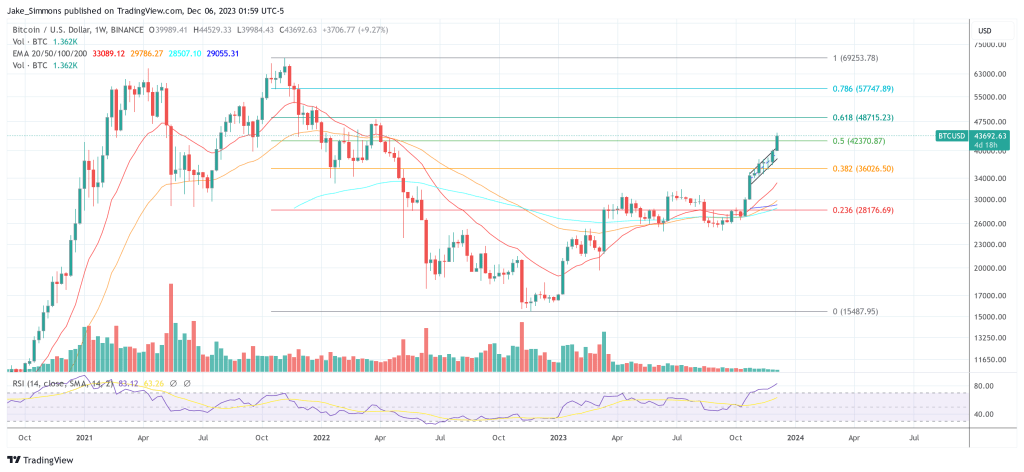
The US Securities and Exchange Commission (SEC) is currently actively working with applicants of spot Bitcoin Exchange-Traded Funds (ETFs), guiding them through what appears to be the final stages of amendments before potential approval. This active engagement is evidenced by the frequent updates to the S-1 filings made public.
In a recent development, BlackRock submitted an updated S-1 application for its spot Bitcoin ETF. This submission has caught the attention of industry experts who have pinpointed a particularly notable change, sparking discussions and speculations within the Bitcoin community.
Does The SEC Demand A Bitcoin ETF Kill Switch?
The crux of the matter lies in what some experts interpret as the SEC’s implicit demand for a ‘kill switch’ in Bitcoin ETFs. Tuur Demeester, founder of Adamant Research and a board member of the Texas Bitcoin Foundation, drew attention to this issue, stating, “SEC demanding a Bitcoin ETF kill switch?”
He referenced a post by lawyer Joe Carlasare, highlighting a significant change in the language of BlackRock’s S-1 filing. This amendment by BlackRock implies severe consequences if Bitcoin is ever classified as a security within the United States. It suggests that such a classification would make it challenging to trade, clear, or custody Bitcoin, with a potentially drastic impact on its market value and liquidity.
Carlasare, a partner at Amundsen Davis, expressed his perspective on this matter, stating, “Interesting update to the BlackRock / iShares S-1 filing regarding the concern that the SEC could take an approach that Bitcoin is a potential security. Seems silly, but apparently the SEC wants that language in there.”
Interesting update to BlackRock / IShares S-1 filing regarding the concern that the SEC could take an approach that Bitcoin is a potential security 🧐
Seems silly, but apparently the SEC wants that language in there. pic.twitter.com/84sCkgFncC
— Joe Carlasare (@JoeCarlasare) December 5, 2023
This view is reflected in the BlackRock S-1 amendment itself, which starkly states that any SEC or state securities regulator action asserting Bitcoin as a security would have a material adverse impact on its trading value and the shares of the ETF. The document draws a parallel with the case of XRP and Ripple Labs, where SEC action led to a significant drop in XRP’s market capitalization.
The amendment states, “Any enforcement action by the SEC or a state securities regulator asserting that Bitcoin is a security, or a court decision, to that effect would be expected to have an immediate material adverse impact on the trading value of Bitcoin, as well as the Shares. […] If a digital asset is determined or asserted to be a security, it is likely to become difficult or impossible for the digital asset to be traded, cleared or custodied in the United States […].
Just Legal Stuff?
Caitlin Long, CEO of Custodia Bank, chimed into the discussion, connecting this update to a recent legislative move in New Jersey, which proposes defining all virtual currencies sold to institutional investors as securities. Long queried Samuel Andrew about this, “Think that’s a ‘hidden’ poison pill that the anti Bitcoin crowd is inserting into the ETF docs??”
Andrew answered, “To answer more directly per an SEC source: ‘Lawyers being lawyers… doing their lawyering.’ Not a short term concern.” Adding a layer of confirmation to these speculations, Carlasare stated that he has reliable information indicating that the contentious language in the S-1 filings was specifically requested by the SEC. “I now have on good authority that this language was specifically requested by the SEC,” he stated.
This revelation suggests that the inclusion of such risk disclosures may not be a voluntary move by BlackRock, but rather a compliance measure in response to SEC directives. The fact that similar language is appearing in other ETF applications further points to the SEC’s hand in shaping these disclosures. However, it is not clear whether this is a ‘kill switch’ or just ‘legal stuff’.
At press time, BTC traded at $43,692.

































